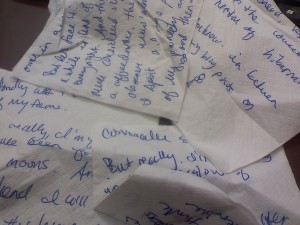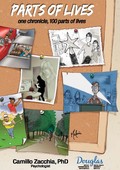 When I see a particular client it doesn’t take me long to find her file in my file cabinet. It’s the one with the colour-coded tabs sticking out. These tabs form part of the many background documents she wrote for me to assist in the treatment process. Meanwhile, I have another client who has yet to complete a simple questionnaire given to him several sessions ago. I’ve given up asking him for it. I’d like to thank both of them for inspiring today’s column.
When I see a particular client it doesn’t take me long to find her file in my file cabinet. It’s the one with the colour-coded tabs sticking out. These tabs form part of the many background documents she wrote for me to assist in the treatment process. Meanwhile, I have another client who has yet to complete a simple questionnaire given to him several sessions ago. I’ve given up asking him for it. I’d like to thank both of them for inspiring today’s column.
Pie charts and scribbled napkins (Voir plus bas pour la version Française)
(Source: Camemberts et gribouillages. Journal Métro, May 07, 2013)Psychologists like to give homework to clients. A record of events, thoughts, and reactions can be a very useful tool in establishing patterns. In a typical homework assignment we may ask people to record where and when they panic, or what was happening when they felt particularly sad, or when they got angry. The problem is that not everyone uses the tool the same way.
Some people record events well. Others simply don’t bring in anything. Then there are the really interesting ones. Some people will scribble a few words on a napkin in the waiting room before their next appointment, while others bring me color-coded pie charts. The ones who bring in the pie charts usually consult for burnout. Imagine that.
I really hate to read too much into a single observation – it is one of the worst things about pop psychology – but scribbled napkins and pie charts? Come on! Who can resist?
Scribbled napkins
What do we make of the napkin scribblers? They probably don’t care too much about the quality of their work or about what others may think. This isn’t always a bad thing. People who don’t take things too seriously are usually relaxed and easy going. They are great to have a beer with on the back deck. Unfortunately their low standards often catch up with them. Their lives can fall apart when they disappoint colleagues, friends, or bosses, who might expect better from them.Pie charts
The ones who bring me color-coded pie charts have standards that are way too high. The quality of their work is spectacular and they often become the go-to people in every office. This makes us ask even more of them, but eventually something has to give. Since they put a superhuman effort into every task they almost always burn out.Which is the better trait?
So which personality trait is best and whom would you rather have as a friend or employee? That would depend a lot on circumstances since a trait can be a strength in one situation and a liability in another. You would probably prefer to hang with the napkin scribbler with his easy going and uncomplicated nature. But the pie-charter is the one you want to have as an employee, as your doctor, or as the person you buy your second-hand car from. Along with a clean well-maintained car, you will probably receive a complete history of oil changes and repairs. Beautiful work. Something you and your napkin scribbler will be able to admire while drinking that beer. Just make sure the napkin scribbler isn’t the one who built your deck.
___________________________________________________________
Voici la version Française:
Les psychologues aiment bien donner des devoirs à leurs clients. Les comptes rendus d’événements, de pensées et de réactions peuvent être très utiles pour dresser un profil. Dans un devoir type, nous pouvons demander à quelqu’un à quel endroit et pourquoi il panique, ou bien ce qui se passait lorsqu’il s’est senti particulièrement triste ou fâché. Le problème, c’est que les gens n’utilisent pas les outils de la même façon.
Certains sont doués pour noter les événements. D’autres arriveront les mains vides. Puis, il y a les gens vraiment intéressants. Certains gribouillent quelques mots sur une napkins dans la salle d’attente avant leur rendez-vous, alors que d’autres m’apportent des diagrammes à secteur (camemberts) avec code de couleurs. Ce sont habituellement ceux qui viennent me consulter pour un épuisement professionnel…
Je n’aime pas porter trop loin l’interprétation d’une simple observation : c’est l’un des pires aspects de la psychologie populaire. Mais, qui peut résister aux gribouillages et aux camemberts?
Les gribouillages
Que penser de ceux qui gribouillent? Ils ne se soucient probablement pas tellement de la qualité de leur travail ou de ce que les autres pensent. Ce n’est pas toujours un mal. Ceux qui ne prennent pas les choses trop au sérieux sont habituellement détendus et faciles à vivre. Il est agréable de prendre une bière avec eux sur notre terrasse. Malheureusement, leurs normes peu élevées leur jouent parfois des tours. Leur vie peut s’effondrer lorsqu’ils déçoivent des collègues, des amis ou des supérieurs, qui pourraient s’attendre à mieux de leur part.Les camemberts
Ceux qui m’apportent des diagrammes en couleur ont parfois des exigences démesurées. La qualité de leur travail est spectaculaire, et ils deviennent souvent la personne à consulter au bureau. Nous leur en demandons toujours plus, mais comme ils déploient des efforts surhumains dans pratiquement toutes les tâches, ils aboutissent fréquemment à l’épuisement professionnel.Quel est le meilleur trait de caractère?
Alors, quel trait de personnalité vaut-il mieux avoir? Qui voudriez-vous avoir comme ami ou comme employé? Cela dépend d’un tas de circonstances, étant donné qu’un trait de caractère peut constituer une force dans une situation, et une faiblesse, dans une autre. Vous auriez probablement plus envie de sortir avec le gribouilleur, qui est facile à vivre. Mais l’auteur des diagrammes est celui que vous voudrez comme employé, comme médecin, ou comme la personne qui vous vendra une voiture d’occasion. En plus d’obtenir un véhicule bien entretenu, vous recevrez probablement tout le dossier des vidanges d’huile et des réparations. Magnifique! Vous et votre gribouilleur de napkins pourrez admirer ce beau document en sirotant une bière. Mais, assurez-vous que ce n’est pas le gribouilleur qui a construit votre terrasse…
Tagged as burnout, high standards, low standards, Stress, unrelenting standards, Workaholic.
Posted in Human nature, Stress.
Posted on 07 May 2013
